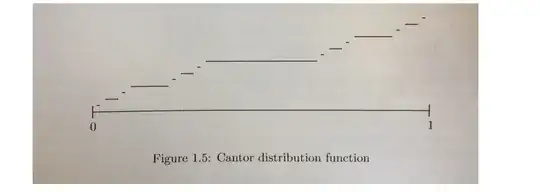On p11, Durrett:
Example 1.2.4 Uniform distribution on the Cantor set. The Cantor set $C$ is defined by removing $(1/3, 2/3)$ from $[0,1]$ and then removing the middle third of each interval that remains. We define an associated distribution function by setting $F(x) = 0$ for $x\leq 0$, $F(x) = 1$ for $x\geq 1$, $F(x) = 1/2$ for $x\in[1/3, 2/3]$, $F(x) = 1/4$ for $x\in[1/9, 2/9]$, $F(x) = 3/4$ for $x\in[7/9,8/9]$, ... There is no $f$ for which $(1.2.1)$ holds because such an $f$ would be equal to $0$ on a set of measure $1$. From the definition, it is immediate that the corresponding measure has $\mu(C^c) = 0$.
I just don't understand why the author called it a uniform distribution. In what sense? Clearly the PDF doesn't exist so the "uniformity" isn't to be interpreted in the PDF sense. So why is such a distribution called uniform?
